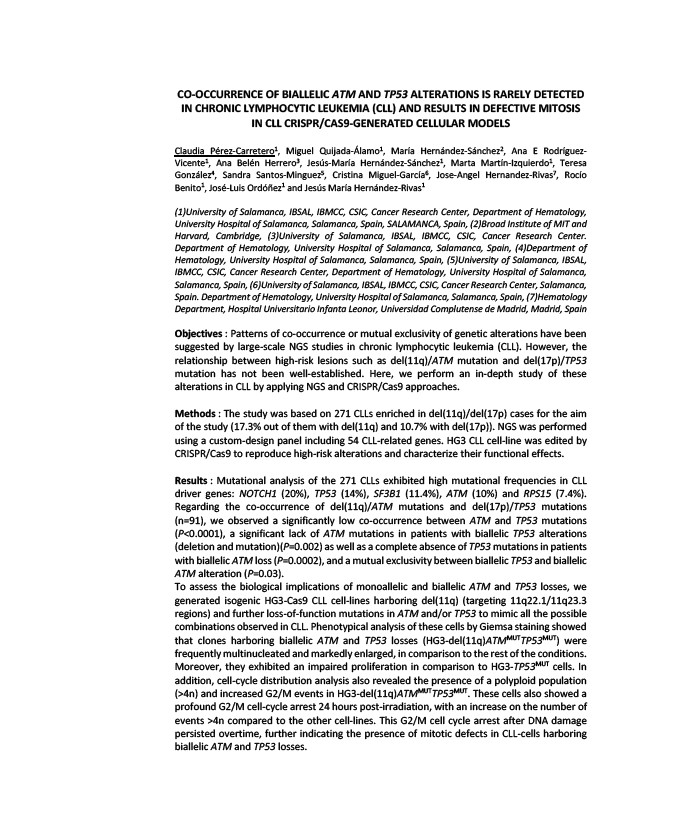
CO-OCCURRENCE OF BIALLELIC ATM AND TP53 ALTERATIONS IS RARELY DETECTED
IN CHRONIC LYMPHOCYTIC LEUKEMIA (CLL) AND RESULTS IN DEFECTIVE MITOSIS
IN CLL CRISPR/CAS9-GENERATED CELLULAR MODELS
Claudia Pérez-Carretero1, Miguel Quijada-Álamo1, María Hernández-Sánchez2, Ana E Rodríguez-
Vicente1, Ana Belén Herrero3, Jesús-María Hernández-Sánchez1, Marta Martín-Izquierdo1, Teresa
González4, Sandra Santos-Minguez5, Cristina Miguel-García6, Jose-Angel Hernandez-Rivas7, Rocío
Benito1, José-Luis Ordóñez1 and Jesús María Hernández-Rivas1
(1)University of Salamanca, IBSAL, IBMCC, CSIC, Cancer Research Center, Department of Hematology,
University Hospital of Salamanca, Salamanca, Spain, SALAMANCA, Spain, (2)Broad Institute of MIT and
Harvard, Cambridge, (3)University of Salamanca, IBSAL, IBMCC, CSIC, Cancer Research Center.
Department of Hematology, University Hospital of Salamanca, Salamanca, Spain, (4)Department of
Hematology, University Hospital of Salamanca, Salamanca, Spain, (5)University of Salamanca, IBSAL,
IBMCC, CSIC, Cancer Research Center, Department of Hematology, University Hospital of Salamanca,
Salamanca, Spain, (6)University of Salamanca, IBSAL, IBMCC, CSIC, Cancer Research Center, Salamanca,
Spain. Department of Hematology, University Hospital of Salamanca, Salamanca, Spain, (7)Hematology
Department, Hospital Universitario Infanta Leonor, Universidad Complutense de Madrid, Madrid, Spain
Objectives : Patterns of co-occurrence or mutual exclusivity of genetic alterations have been
suggested by large-scale NGS studies in chronic lymphocytic leukemia (CLL). However, the
relationship between high-risk lesions such as del(11q)/ATM mutation and del(17p)/TP53
mutation has not been well-established. Here, we perform an in-depth study of these
alterations in CLL by applying NGS and CRISPR/Cas9 approaches.
Methods : The study was based on 271 CLLs enriched in del(11q)/del(17p) cases for the aim
of the study (17.3% out of them with del(11q) and 10.7% with del(17p)). NGS was performed
using a custom-design panel including 54 CLL-related genes. HG3 CLL cell-line was edited by
CRISPR/Cas9 to reproduce high-risk alterations and characterize their functional effects.
Results : Mutational analysis of the 271 CLLs exhibited high mutational frequencies in CLL
driver genes: NOTCH1 (20%), TP53 (14%), SF3B1 (11.4%), ATM (10%) and RPS15 (7.4%).
Regarding the co-occurrence of del(11q)/ATM mutations and del(17p)/TP53 mutations
(n=91), we observed a significantly low co-occurrence between ATM and TP53 mutations
(P<0.0001), a significant lack of ATM mutations in patients with biallelic TP53 alterations
(deletion and mutation)(P=0.002) as well as a complete absence of TP53 mutations in patients
with biallelic ATM loss (P=0.0002), and a mutual exclusivity between biallelic TP53 and biallelic
ATM alteration (P=0.03).
To assess the biological implications of monoallelic and biallelic ATM and TP53 losses, we
generated isogenic HG3-Cas9 CLL cell-lines harboring del(11q) (targeting 11q22.1/11q23.3
regions) and further loss-of-function mutations in ATM and/or TP53 to mimic all the possible
combinations observed in CLL. Phenotypical analysis of these cells by Giemsa staining showed
that clones harboring biallelic ATM and TP53 losses (HG3-del(11q)ATMMUTTP53MUT) were
frequently multinucleated and markedly enlarged, in comparison to the rest of the conditions.
Moreover, they exhibited an impaired proliferation in comparison to HG3-TP53MUT cells. In
addition, cell-cycle distribution analysis also revealed the presence of a polyploid population
(>4n) and increased G2/M events in HG3-del(11q)ATMMUTTP53MUT. These cells also showed a
profound G2/M cell-cycle arrest 24 hours post-irradiation, with an increase on the number of
events >4n compared to the other cell-lines. This G2/M cell cycle arrest after DNA damage
persisted overtime, further indicating the presence of mitotic defects in CLL-cells harboring
biallelic ATM and TP53 losses.